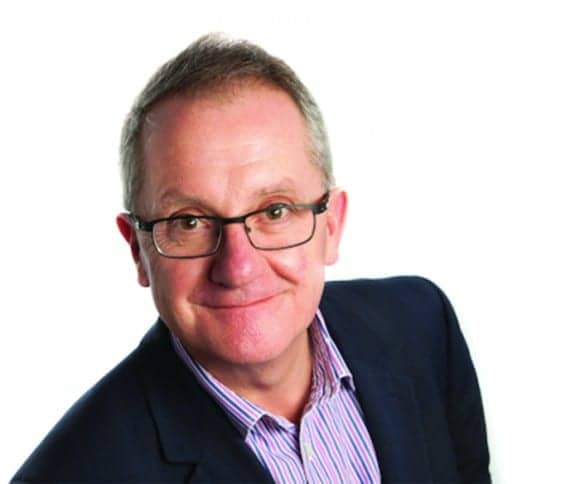Inside Clinical Research | January 2016 Hearing Review
Editor’s note: This is the first installment of a new column written by long-time Hearing Review contributor Douglas L. Beck, AuD, who will take a deeper look at the intriguing research being conducted in hearing healthcare and related fields.
A few weeks ago, I had the opportunity to interview David M. Baguley, PhD, MBA, the Head of Audiology/Hearing Implants at Cambridge University Hospitals NHS Trust in Cambridge, England. Dr Baguley has published more than 150 peer-reviewed publications, and is the co-author of Tinnitus: A Multidisciplinary Approach, Second Edition (Wiley-Blackwell, 2013) and Hyperacusis: Mechanisms, Diagnosis, and Therapies (Plural Publishing, 2007). He is also the former audiology section editor of the UK’s ENT & Audiology News, and has co-edited the latest edition of Ballantyne’s Deafness (Wiley-Blackwell, 2009), as well as a self-help book on tinnitus and hyperacusis, Living with Tinnitus and Hyperacusis, with Lawrence McKenna and Don McFerran (Sheldon Press, 2010).
Beck: I suspect most of our readers are familiar with your extensive peer-reviewed publications and many of the books you’ve authored and co-authored…but today I’d like to focus on your newest 2015 book, Tinnitus: Clinical and Research Perspectives, available from Plural Publishing, co-edited by Prof Marc Fagelson.
Baguley: Sure thing, Doug. That’s great.
Beck: And to be fair, there are 21 chapters in the new book—covering everything from animal models of tinnitus and hyperacusis, tinnitus in films and music, somatic modulation of tinnitus, misophonia, and so much more—but we’re going to focus on clinical aspects of tinnitus, and how hearing healthcare professionals participate daily in taking care of the tinnitus patient, as part of a multi-disciplinary approach.
And so that gets me to square one: hearing aids. In my research and practice, it seems obvious to me that the number-one treatment of all time to help the tinnitus patient manage their tinnitus is hearing aids. Is that correct?
Baguley: Yes, I would agree. No doubt at all. Hearing aids are an enormous help for most tinnitus patients, most of the time, even when their hearing loss is mild. And although there are no shortages of success stories for the tinnitus patient using hearing aid amplification, as a profession we haven’t been very good at documenting the specific details as to how to select the best candidates, which approaches work best, which tools are best for which patient, and so on. We need to document specific diagnostic and treatment protocols for these patients, and I’d like to see us have better protocols addressing how to assess and treat patients suffering with tinnitus.
Beck: Fair enough. I agree. We have lots of case reports and anecdotal successes, but we need more science. Specifically, we need longitudinal outcomes-based studies comparing experimental group and control groups, or randomized controlled trials (RCTs) to better capture facts and data, rather than trends and implications.
In fact, as we don’t have hard and fast numbers, let me ask you about the “80/80 Rule.” When I was reviewing the literature in 2012 for the British Academy of Audiology (BAA), it seemed apparent that 80% of all tinnitus patients have sensorineural hearing loss (SNHL) and 80% of all patients with SNHL have tinnitus. Do those numbers sound right to you?
Baguley: Absolutely. The 80/80 Rule seems correct to me. Further, in the UK right now, there is work going on with regard to mild-moderate SNHL to determine how many of those patients have troublesome tinnitus, which is perhaps a different question, but it might be very important to see if there are clear differences in tinnitus based on degree of hearing loss. It’s a relatively simple question, but we really don’t have answers on this, as of yet.
Beck: One specific question which comes up a lot in the day-to-day management of tinnitus patients is the treatment of unilateral tinnitus after medical clearance. Given that scenario, do you fit amplification on one or two ears?
Baguley: I think you have to go bilateral on these fittings wherever there is some hearing loss. If you fit one ear only, you’re very likely to replace their tinnitus with an even more annoying sense of imbalance, everything being louder on the one ear, and of course the asymmetry is likely to not be very pleasant.
Beck: In your new book, Grant Searchfield authored a brilliant chapter titled “Hearing Aids for Tinnitus.” Grant seems to agree with Henry, Frederick, and colleagues1 who stated hearing aids with and without sound generators provided significant benefit with regard to reducing the effects of tinnitus, but importantly, there were no statistical differences in the outcomes based on the instrument selected (with or without a masker). That is, 87% reported meaningful reductions in their tinnitus using either device—which is clearly a remarkable outcome!
Baguley: This is a really important area for us. I’m happy to tell you we’re exploring this area currently, too, and are involved in an RCT [randomized controlled trial] to try to pin this issue down. We have wonderful and vast opportunities with combination devices for tinnitus, but we don’t know how much the patients embrace them; we are unsure if the sound source itself matters, and there’s a lot to learn here about which patient to select for traditional amplification versus which patient to select for hearing aids with a masker—and how to set these things maximally after we’ve selected the best alternative!
Beck: Seems to me the best masking noises would be relatively meaningless, pleasant sounds like the ocean, a shower sound, rain on the roof, fractal tones, and so on. But I have no data to support those presumptions. However, if I were suffering from tinnitus and you gave me white noise or pink noise, which are not very pleasant to listen to, I cannot imagine adhering to that protocol.
Baguley: Intuitively, I agree…but that’s why we need scientific studies to better select the best sounds. And, of course, we need to be ready for the fact that the sound the patient prefers this week may be very different from the sound they prefer in a few weeks or months. As Grant mentions in his chapter, there are many potential reasons why hearing aids are beneficial for the tinnitus patient, such as providing an alternative sound to listen to. Simply by masking the tinnitus percept—and if we presume 80% of tinnitus patients have hearing loss—with hearing aids is likely to help de-stress these patients and allow them to communicate more easily and engage in pleasant social situations, which their untreated hearing loss may prevent them from enjoying.
Beck: David, I’m very glad you mentioned that, and I want to dig a little deeper on stress. One of my key lecture points about tinnitus is that “tinnitus is very often a manifestation of stress.” That is, hearing, the auditory system, the brain, and the general health of the patient all are important factors—but the thing which seems to separate the tinnitus patient from the non-patient is their level of stress.
Baguley: This is an important area. Whilst I see few cases in which stress has been directly causal of tinnitus, I see many where stress and anxiety can exacerbate tinnitus. Given that tinnitus can also increase stress and anxiety, this is a two-way street. Chapters in the new book on models of tinnitus look at these ideas in detail, with practical and clinical insights.
Beck: Additionally, I know you advocate a multi-disciplinary approach to tinnitus. Would you elaborate on that?
Baguley: Yes, of course. Tinnitus patients sometimes require more specialized care than that which the audiologists provide. That is, the ENT, the family practitioner, psychologists, and other counselors often contribute quite a bit to the care of the tinnitus patient. In fact, that was the focus of our 2nd edition of The Multi-Disciplinary Approach to Tinnitus in 2013. Of the patients who come to see the audiologist or ENT for tinnitus, I would expect we can likely help about two-thirds of them using audiologic solutions…but many tinnitus patients never see anyone in hearing healthcare. That is, their point of entry may be a psychologist, psychiatrist, neurologist, a GP—and perhaps if it appears the patient has no hearing loss, no audiologist ever sees them. Again, there’s still quite a lot to learn!
Beck: And, of note, you advocate Cognitive Behavioral Therapy (CBT) to help people with tinnitus? [CBT for tinnitus is a psychological treatment to identify and modify unhelpful thoughts and behaviors. CBT involves identifying and modifying maladaptive behaviors, thoughts, and feelings.]
Baguley: Absolutely. CBT tactics have a real role to play here. As you recall, Doug, in 2012, I was involved in a group that published in The Lancet “Specialized treatment based on cognitive behavior therapy versus usual care for tinnitus: a randomized controlled trial.”2 In that publication we presented the results of some 490 patients treated with CBT, as compared to 247 patients with “usual care” between 2007 and 2011. We looked at many things, but the primary thing was health-related quality of life (QOL). Those treated with CBT experienced less tinnitus severity and they experienced statistically significant improvements in their QOL.
Beck: David, you’ve been very generous with your time today, and I thank you for that. I suspect you and I can talk about tinnitus for hours. I’ll conclude by saying the new book is excellent, highly revealing, and immediately applicable—and I urge our colleagues to get a copy.
Baguley: Thanks Doug. I’m so pleased to chat with you and I am delighted that you’ve found the book to be interesting!
References
-
Henry JA, Frederick M, Sell S, Griest S, Abrams H. (2015) Validation of a Novel Combination Hearing Aid and Tinnitus Therapy Device. Ear Hear. 36(1):42-52. doi: 10.1097/AUD.0000000000000093
-
Cima RF, Maes IH, Joore MA, Scheyen DJ, El Refaie A, Baguley DM, Anteunis LJ, van Breukelen GJ, Vlaeyen JW. Specialised treatment based on cognitive behaviour therapy versus usual care for tinnitus: a randomised controlled trial. Lancet. 2012 May 26;379(9830):1951-1959. doi: 10.1016/S0140-6736(12)60469-3.
Recommended Reading
Baguley DM, Atlas MD. Cochlear implants and tinnitus. Prog Brain Res. 2007;166:347-55.
Baguley DM, Bird J, Humphriss RL, Prevost AT. The evidence base for the application of contralateral bone anchored hearing aids in acquired unilateral sensorineural hearing loss in adults. Clin Otolaryngol. 2006;31(1):6-14
Baguley DM, Phillips J, Humphriss RL, Jones S, Axon PR, Moffat DA. The prevalence and onset of gaze modulation of tinnitus and increased sensitivity to noise after translabyrinthine vestibular schwannoma excision. Otol Neurotol. 2006;27(2):220-224.
Baguley DM, Jones S, Wilkins I, Axon PR, Moffat DA. The inhibitory effect of intravenous lidocaine infusion on tinnitus after translabyrinthine removal of vestibular schwannoma: a double-blind, placebo-controlled, crossover study. Otol Neurotol. 2005;26(2):169-76
Douglas L. Beck, AuD, is among the most prolific authors in audiology with 148 published articles, more than 1250 abstracts, interviews, and op-eds written for the AAA (2008-2015) and AudiologyOnline (1999-2005) websites, addressing a wide variety of audiology and professional topics. In addition to his new role as Senior Editor for Clinical Research at The Hearing Review, Dr Beck is an Associate Professor of Audiology at the University of Hawaii and Director of Professional Relations at Oticon Inc, Somerset, NJ.
Correspondence can be addressed to Hearing Review or Dr Beck at: [email protected]
Original citation for this article: Beck DL. Inside Clinical Research: Clinical Aspects of Tinnitus: An Interview with David Baguley, PhD. Hearing Review. 2016;23(1):40.








Have you heard of tinnitus developing with hydrocephalus…..especially post-shunt revision?